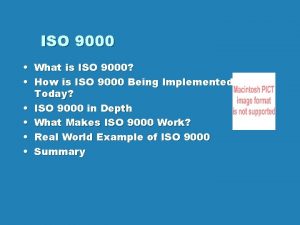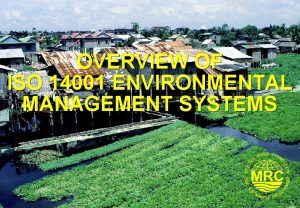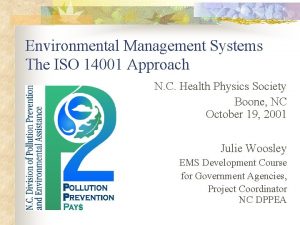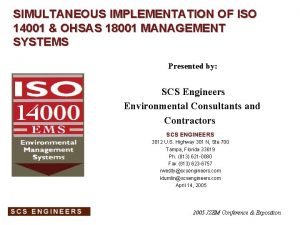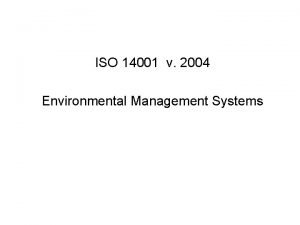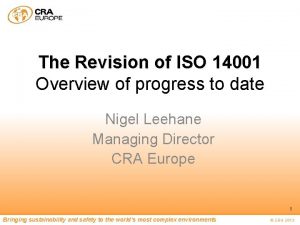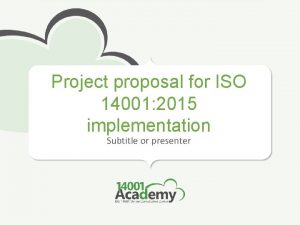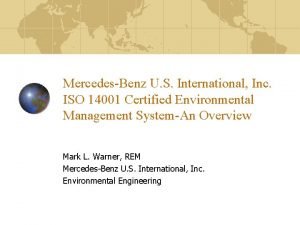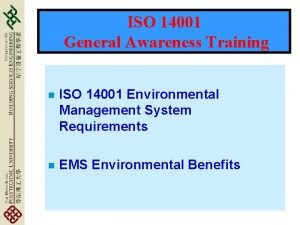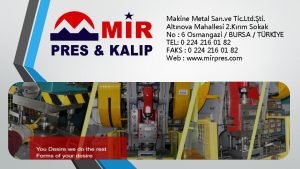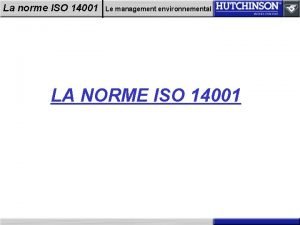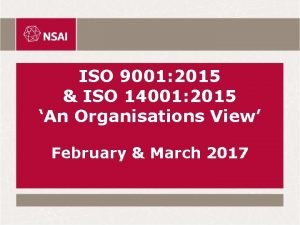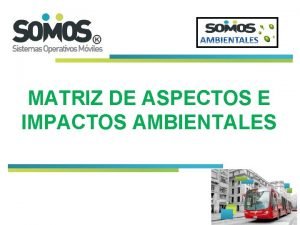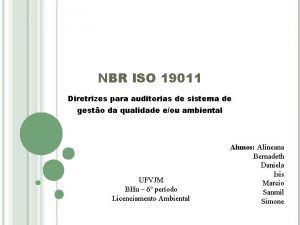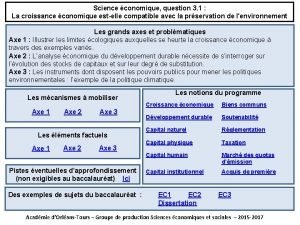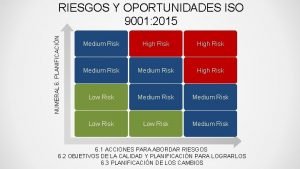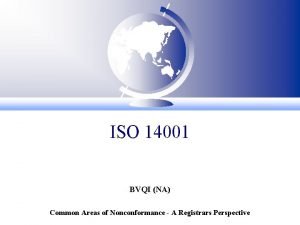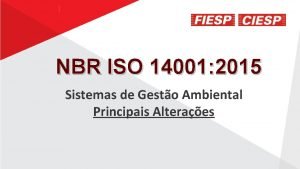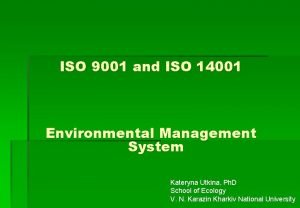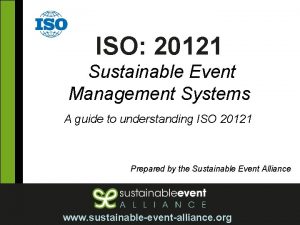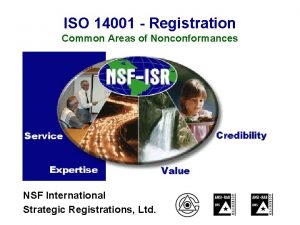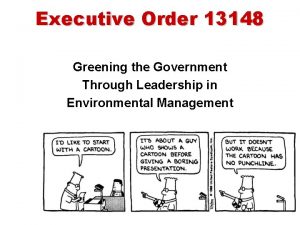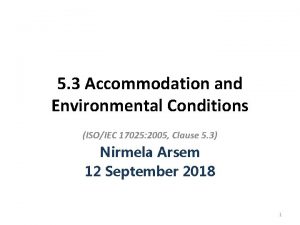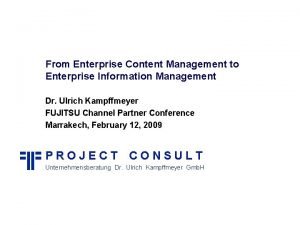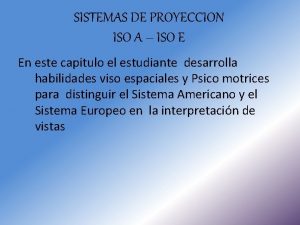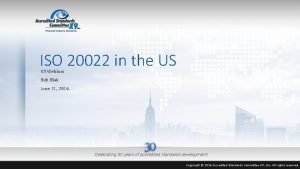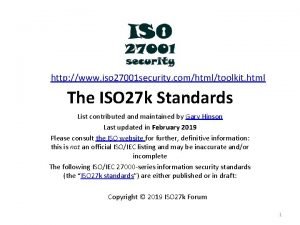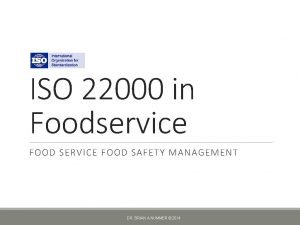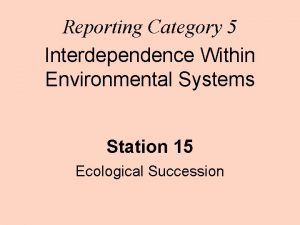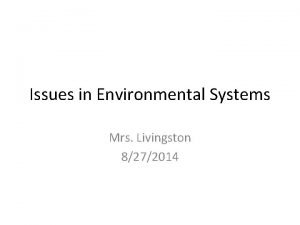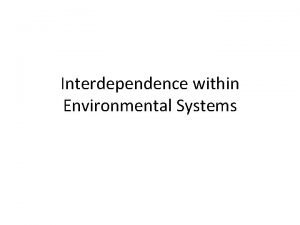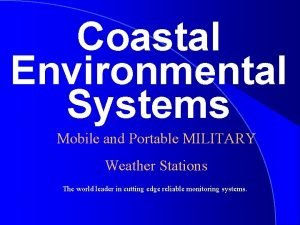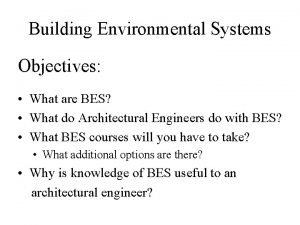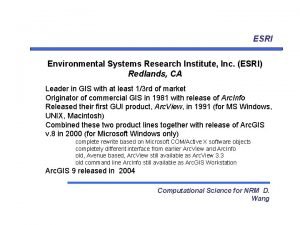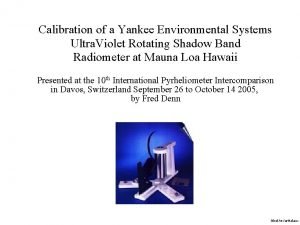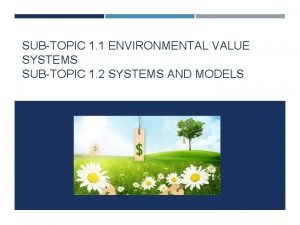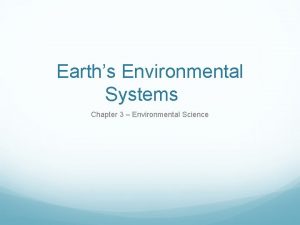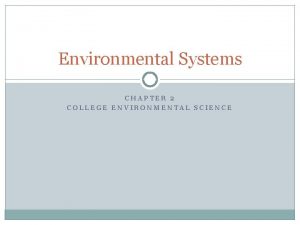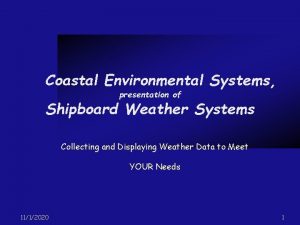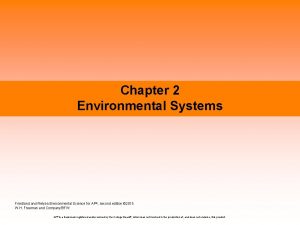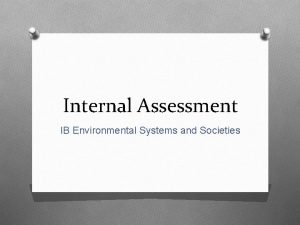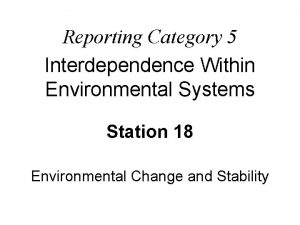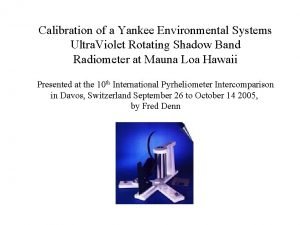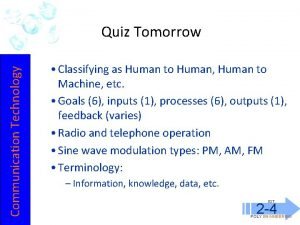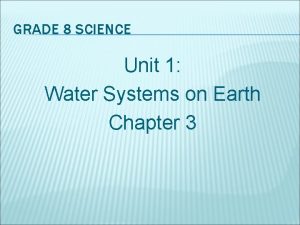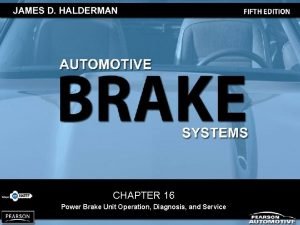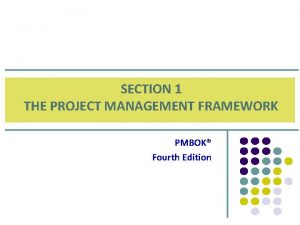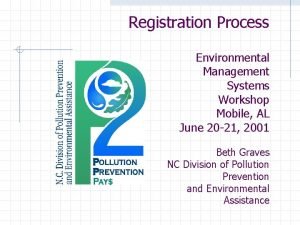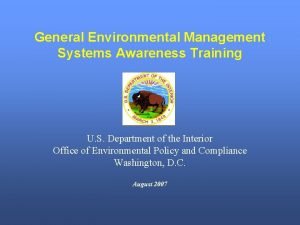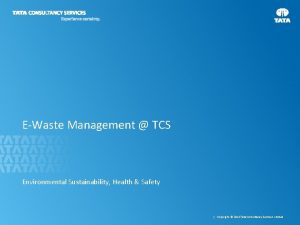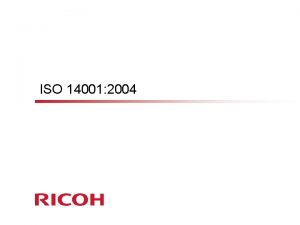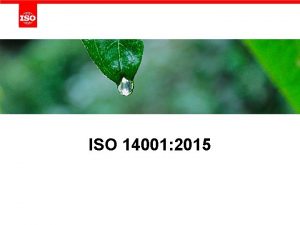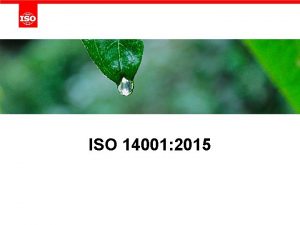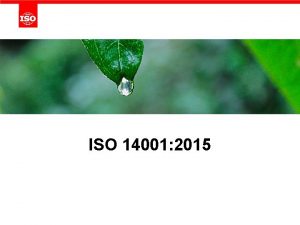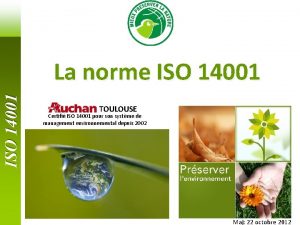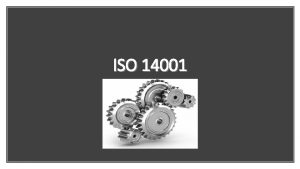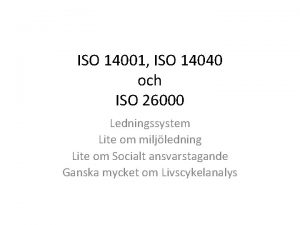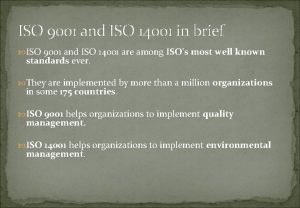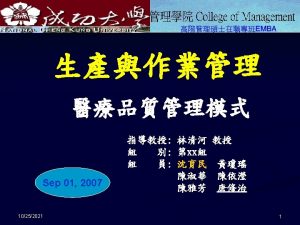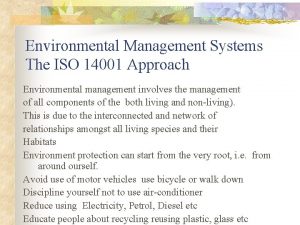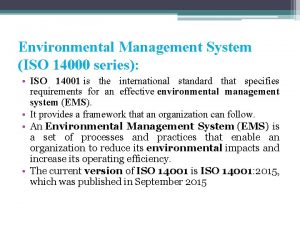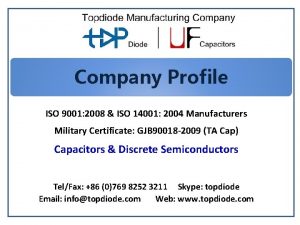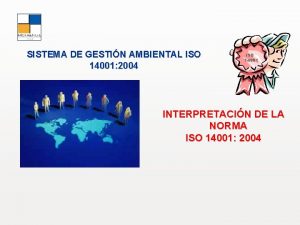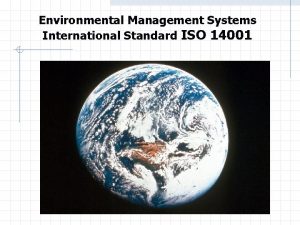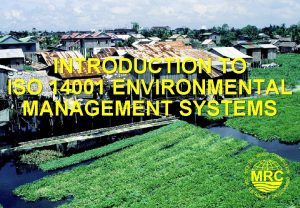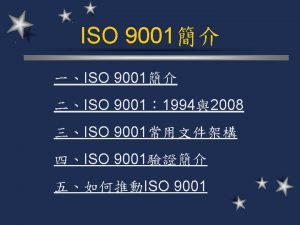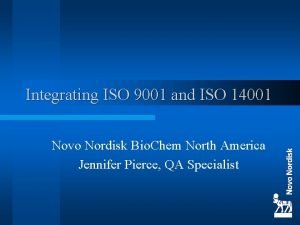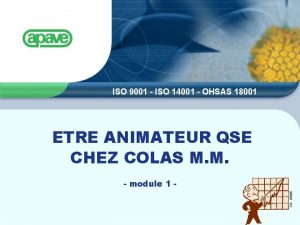ISO 14001 v 2004 Environmental Management Systems Quiz





























































- Slides: 61

ISO 14001 v. 2004 Environmental Management Systems

Quiz 1. According to the ISO 14001 standard, there is a continual improvement of 5 specific phases based on the methodology known as Plan-Do-Check-Act. Which are they? 2. According to the ISO 14001 standard, what is a preventive action, and how it is different from a corrective action?

EMS “A system put into place that keeps things running smoothly” Denso Manufacturing Michigan, Inc. • EMS does not have to be certified ISO 14001 • Plant personnel can develop the EMS with/without consulting support • 3 rd-Party Auditors are needed for ISO 14001 certification

EMS Evolution • Until 1960 s when gained public attention • Corporations reacted to increased legislation • Responsible Care Program (Canada) in 1984 • British created the first national EM standard BS 7750 in 1994 • A Canadian standard Z 750 was created in 1994 • Legislated in 1993, EU published EMAS in 1994, open in 1995. • In the U. S. no national standard was developed during the 1990 s, however groups of companies did (e. g. GEMI) • The first international EMS was ISO 14001 by ISO. • Based on: – The success of ISO 9001 – Increasing international concern (UN Conference of Rio 1992) – Created a Technical Committee 207 • The ISO 14001 was published for the first time in 1996.

Why environmental standards? …to "promote a harmonious and balanced development of economic activities, sustainable and non-inflationary growth respecting the environment… the raising of standards of living and quality of life" (EMAS). …to support environmental protection and prevention of pollution in balance with socio-economic needs (ISO 14001)

EMS and ISO 14001 • First version finalized and issued in 1996, revised every five years (2004 current version) • Market sector created and driven; governments participate but it is not legislative or regulatory • Process standard, not performance • Each participating nation has a committee that develops consensus and contributes (one vote each, for US it is ANSI) • 14001 is one of the standards in the 14000 series


ISO 14001 Standards • Voluntary • Set up the by industry: countries can adapted into their legislation • Is aimed to improve processes not performance itself • Key aspect is that of continual improvement • Doesn’t require the publication of an environmental statement • Provides the company with a guideline on how to manage environmental aspects • Requires management commitments and involvement from all employees

ISO, ANSI, Certifiers • ISO develops International Standards but does not operate any schemes for assessing conformity with them. What ISO is not? • ISO is not an auditor, assessor, registrar, or certifier of management systems, products, services, materials or personnel, nor does it endorse or control any such activities performed by other parties. ANSI coordinates the development of standards in the U. S. and accredit programs that assess conformance with the standards • 750 certification bodies worldwide


Environmental Management System (EMS) Policy Management Review Checking and Corrective Action Planning Implementation and Operation

The ISO 14001 EMS Model 4. 2 Define Policy Products, Services, and Activities 4. 3. 2 Legal Requirements 4. 3. 1 Identify Aspects 4. 3. 3 Identify Objectives Targets and Programs 4. 4 Implementation and Operation 4. 5. 1 Monitoring & Measurement 4. 5. 2 Preventive & Corrective Action 4. 5. 3 Records 4. 5. 4 EMS Audit 3. 2 Continual Improvement 3. 18 Prevention of Pollution 4. 5 Checking 4. 6 Management Review PD CA 4. 4. 1 Resources, Roles, responsibility and authority 4. 4. 2 Competence, Training & Awareness 4. 4. 3 Communication 4. 4. 4 Documentation 4. 4. 5 Document Control 4. 4. 6 Operational Control 4. 4. 7 Emergency Preparedness

ISO 14001 Environmental Standard v 2004 4. 1 General Requirements 4. 2 Environmental Policy 4. 3 Planning – Environmental aspects – Legal and other requirements – Objectives, Targets and Programs 4. 4. Implementation and Operation – – – – Resources, Roles, Responsibilities and Authority Competence, Training and Awareness Communication Documentation Controls of documents Operational control Emergency Preparedness and Response 4. 5 Checking – – – Monitoring and Measurement Evaluation of compliance Nonconformity, Corrective action and Preventive action Control of records Internal audit 4. 6. Management Review

Environmental Policy • The environmental policy describes the organization’s overall approach and intentions. • Is the Keystone upon which the entire EMS is constructed. • NOT A PUBLIC RELATIONS DOCUMENT Policy Management Review Checking and Corrective Action Planning Implementation and Operation

Policy Requirements To meet ISO 14001 requirements, the policy must: 1. Be appropriate to the nature, scale, and environmental impacts of the organization activities and goods produced. 2. Include a commitment to continual improvement and prevention of pollution. 3. Include a commitment to relevant legal requirements. 4. Provide a framework for setting and reviewing environmental objectives and targets. 5. Be documented, implemented and maintained, and communicated to all employees (also contractors) 6. Be available to the public.

Policy Statement • Organization must be able to demonstrate that it is fully aware of all relevant environmental issues and their potential impact and importance. • No list is appropriate to all organizations; each establishes methods/measures relevant to its operations.

Policy Statement • Provides a framework for setting environmental objectives – Objectives are specific and defined goals that need to be achieved in order to meet the requirements of the Environmental Policy. – Every action, requirement, procedure, etc. contained within the EMS must have its roots in the Env. Policy Statement.

Policy Statement • Commitment to continual improvement – “Process of enhancing the environmental management system to achieve improvements in overall environmental performance in line with the organization's environmental policy. “ – Ties together the Env. Policy Statement and Management Review elements of ISO 14001. • Requires the EMS be reviewed and evaluated at a set frequency for changed aspects and impacts (yearly is generally acceptable).

Policy Statement • Commitment to P 2 – After pollution based objectives have been set, P 2 must be evaluated at one of the alternative approaches to setting the Target(s). – If P 2 is not cost-effective, it does not have to be accepted.

Policy Statement • Commitment to Compliance with Laws, Regs, and Requirements – Identify applicable laws & regs – Determine compliance – Develop action plan to correct noncompliance – Establish a system to maintain compliance • Organization does not need to be in full compliance in order to conform with 14001 • Continued pattern of noncompliance may need to nonconformance with ISO 14001.

Policy Statement • Documentation and Communication – Executive level manager must sign the Policy Statement and maintained based on Document Control (4. 4. 5) proceedures. – All employees must understand recognize the commitments and relate their job functions with the Policy. – Policy must be communicated with the public.

Planning – Environmental Aspects. Policy Management Review Planning – Legal and Other Requirements. – Objectives and Targets. Checking and Corrective Action Implementation and Operation – Environmental Management Program • Dynamic • Integrated

Planning Identify Activities, Products and Services Identify Environmental Aspects and Impacts Determine Priority Environmental Aspects Determine Legal and Other Requirements Establish Objectives and Targets Develop Environmental Management Program

Activities, Products and Services • This is where is described what the facility does – Consider mission – what ‘facility’ is designed to do e. g. fast delivery of documents/packages – Consider activities that support the mission e. g. vehicle maintenance – Consider actions that are both regulated and not regulated e. g. commuting to work

Aspects and Impacts • Identify environmental aspects of activities products and services that can be controlled and over which can be expected to have an influence” – Aspects: Element of an organization's activities, products or services that can interact with the environment. – Impacts: Any change to the environment, whether adverse or beneficial, wholly or partially resulting from an organization's activities, products or services Video

Aspects and Impacts • Content Requirements of Environmental Aspects – understand how organization interacts with the environment – control versus influence – arrive at a list of significant environmental aspects based upon impacts – develop a procedure to support the three step decision making process Video

Determine Significant Aspects • The process of arriving at a list of Significant Environmental Aspects must be a reasonable and understandable procedure be based upon the following criteria: 1. 2. 3. 4. 5. 6. 7. 8. perceived risk(human health vs. ecosystem); impact analysis (internal, local, regional, global); probability of occurrence direct or indirect control; regulated or non-regulated; resource utilization; community interest; etc. • Consider normal, unique, and emergency conditions • Where do opportunities exist for improvement?

Legal and Other Requirements • Identify legal requirements that apply to a facility’s activities – use audit guides or protocols • Identify other requirements that apply including corporate policies, Executive Orders (public organizations), facility initiatives or voluntary practices • ISO 14001 does not require documentation for the Legal and Other Requirements section (4. 3. 2). However, the only practical way to demonstrate conformance is to assemble in one place a list and copies of each applicable environmental law, regulation and voluntary subscription along with the supporting permits and/or contracts as evidence.

Objectives and Targets • Consider “legal and other requirements” • Consider significant aspects • Reflect corporate policies • Reflect financial and technical limitations • Reflect “interested parties” • Reflect policy commitment and commitment to pollution prevention • Consider how you will measure progress

Objectives and Targets • Objectives are the “Goals” that support the “Vision” contained in the Environmental Policy Statement.

ISO 14001 Specifications for Objectives/Targets • • • The ISO 14001 Standard stipulates several criteria that must be considered when establishing environmental objectives. Specifically: Environmental policy commitments to continual improvement, prevention of pollution, and compliance with legal and other requirements. Concentration on controlling significant environmental aspects – the activities, products, and services with the highest environmental impacts – since reducing their significance (i. e. , the risks associated with them) automatically lowers their impacts. Taking consideration of technological options and financial, operational, and business requirements means that environmental objectives and targets must be practical in terms of being technologically achievable, within the limits of available budget constraints, and consistent with operational and business strategies. – In other words, objectives and targets must be realistic and attainable, not mere dreams or wish lists. The views of interested parties. Any individual, group, agency, or community that may be affected by or have a stake in the operations of the facility implementing the EMS. This can be a long list, including: – National, regional/provincial, local government officials – Local community representatives – Public interest groups and other stakeholders (The views of interested parties are also helpful when an organization makes a decision regarding communication of its environmental aspects).

ISO 14001 Environmental Management Programs: The organization shall establish and maintain programs for achieving its objectives and targets, including: (a) designation of responsibility for achieving objectives and targets at each level and function of the organization (b) the means and time-frame by which they are to be achieved 32

Environmental Management Programs An EMP is an action plan specifying: • How objectives and targets will be accomplished • Who is responsible for achieving them • Who will manage and supervise the activities • Who will carry out the work • What they will do • What resources are needed (e. g. , people, skills, equipment, time, money) • When the tasks will be completed (i. e. , a 33 schedule)


ISO 14001 Planning Sequence 35

Implementation and Operation • This phase includes 7 elements: – Resources, Roles, Responsibilities and Authority – Competence, Training and Awareness Policy Management Review Planning – Communication – Documentation – Controls of documents – Operational control – Emergency Preparedness and Response Checking and Corrective Action Implementation and Operation

Implementation and Operation Organization & Accountability Capabilities & Communications Controls EMS Documentation Training, Awareness and Competence Structure and Responsibility Document Control Operational Control Communication Emergency preparedness and response

Structure and Responsibility • Roles and responsibilities are defined, documented, communicated • Management will provide resources for implementation of the system • Identifies Management Representative (s) – In charge – Report to top management

Training, Awareness and Competence • Ensure training and awareness relevant to – EMS - including policy – relationship between employees’ activities and environmental impacts • Ensure competence training to – regulatory requirements – standard operating procedures

Communication • Ensure internal communication • External communication of significant environmental impacts is optional, however this decision shall be documented • Provide process for responding to external communication

Documentation and Document Control • Procedures for controlling documents – can be located - are legible, dated and maintained – reviewed and revised as necessary and approved – current versions are available to practitioner – obsolete documents are removed from use

Documentation • • • 42 Under ISO 14001, documentation refers to all written material concerning the EMS Documents include policies, procedures, manuals, plans, diagrams, flowcharts, correspondence, memoranda related to the EMS Records are documents, but under ISO 14001 are distinguished from documentation: – Documentation concerns what should happen – Records contain information on what has happened

Must Document 43 4. 2 ENVIRONMENTAL POLICY 4. 3. 3 Environmental objectives and targets 4. 4. 1 Roles, responsibilities, and authority for EMS 4. 4. 3 Communications from external interested parties 4. 4. 4 EMS core elements 4. 4. 6 Procedures essential for operational control 4. 5. 1 Monitoring and measurement of key operations that have potential significant impacts 4. 5. 1 Compliance with laws and regulations 4. 5. 3 Records 4. 6 MANAGEMENT REVIEW

Good Idea to Document 4. 3. 1 4. 3. 2 4. 3. 3 4. 3. 4 4. 4. 2 4. 4. 7 4. 5. 2 4. 5. 5 44 Environmental aspects and impacts inventory Significant environmental aspects Registry of legislation and regulations Environmental management programs action plans to achieve objectives and targets Training needs results, and training plans Emergency response plan Corrective and preventive actions EMS audit results

What are Operational Controls? • 45 Means by which an organization prevents pollution from operations, e. g. : – Pollution control equipment such as scrubbers, filters, precipitators, clarifiers, biological and chemical treatment, etc. – Alarms for gas, p. H, conductance, tank level, etc. – Preventive maintenance practices – Operating procedures

Methods of Operational Control • Process controls: – electronic – mechanical – monitoring – observation • 46 Operating procedures: – verbal – documented

What is a Procedure? • • • 47 An activity carried out according to specified instructions Combination of responsibilities, authority, resources, instructions needed to consistently perform an activity A procedure may be documented (i. e. , written), but the document is NOT the procedure

One More Thing from ISO 14001 4. 4. 6 The organization shall establish and maintain procedures related to the identifiable significant environmental aspects of goods and services used by the organization and communicate relevant procedures and requirements to suppliers and contractors 48

Responsibilities of Contractors and Suppliers • • • 49 The organization is responsible for informing contractors and suppliers about operating procedures relating to their goods and services Contractors must comply with all EMS requirements when on site Suppliers may be required to meet specified environmental standards in their own facilities

Emergency Preparedness and Response • Procedures to address accidents and emergencies – prevent and mitigate environmental impacts – review and revise after emergency or accident – test where appropriate


Checking • 5 elements: Policy – Monitoring and Measurement. – Evaluation of compliance – Non-Conformance and Corrective and Preventive Actions. – Control of Records – EMS Internal Audit. Management Review Checking and Corrective Action Planning Implementation and Operation

Checking Periodic Evaluations of compliance Ongoing Monitoring and Measuring Non-conformance, Corrective and Preventive Action Periodic Internal EMS Audits Records

Monitoring and Measuring • Procedures to monitor and measure activities related to significant aspects – Root cause analysis – Audits – Track performance, operational control and objectives and targets – Maintain and calibrate monitoring equipment

Evaluation of Compliance • Periodically evaluate compliance with applicable legal requirements • Also evaluate compliance with other requirements the company subscribes • Keep records of such evaluations

Nonconformity, Corrective and Preventive Action – Identify cause of nonconformity – Develop corrective action and implement it – Modify procedures if necessary to prevent recurrence – Define responsibility and authority to address non-conformance

Control of Records • Procedures for identification, maintenance and disposition of environmental records – Legible and traceable to the activity, product or service involved

Internal EMS Audits • Periodically audit to determine if the EMS – is being properly implemented and maintained, and – conforms to the standard • Provide audit information to management

Management Review – Policy – Audits Policy Management Review Planning – Corrective and Preventive Action Systems. – Environmental Objectives and Targets. Checking and Corrective Action Implementation and Operation

Management Review Process To Assess the • suitability, Need to consider: • adequacy, and • effectiveness of the EMS • audit findings • progress records on objectives • changes to facilities • changes in activities, products or services • changes in technology • concerns of interested parties • other relevant information In order to determine the need for change and improvement to: • the environmental policy • the objectives and targets • other elements of the EMS

Summary • An EMS is a formal system for managing the environmental footprint of organizations • Most organizations already have several EMS elements in place the system relationship is lacking • An EMS must serve the mission of the organization • The EMS and related measurement tools are just that- tools. Alone, they will not guarantee success. • The organization must use the tools, not just have them. • Success comes from being committed to continual improvement for the long term
 Iso 9000 iso 9001 iso 9002 iso 9003 iso 9004
Iso 9000 iso 9001 iso 9002 iso 9003 iso 9004 Iso 14001 environmental policy examples
Iso 14001 environmental policy examples Iso 14001 environmental policy statement examples
Iso 14001 environmental policy statement examples Iso 9001 iso 14001 ohsas 18001 comparison
Iso 9001 iso 14001 ohsas 18001 comparison Quiz iso 14001
Quiz iso 14001 Iso 14001 revision
Iso 14001 revision Iso 14001 implementation project plan
Iso 14001 implementation project plan Mercedes benz iso 14001
Mercedes benz iso 14001 Iso 14001 2015 awareness training
Iso 14001 2015 awareness training Angst+pfister iso 14001:2015
Angst+pfister iso 14001:2015 Manuel environnement iso 14001 version 2015
Manuel environnement iso 14001 version 2015 Iso 14001 risk and opportunities examples
Iso 14001 risk and opportunities examples Matriz impacto ambiental
Matriz impacto ambiental Nbr iso 19011
Nbr iso 19011 Exemple politique environnementale iso 14001 version 2015
Exemple politique environnementale iso 14001 version 2015 Oportunidades iso 9001
Oportunidades iso 9001 Danone iso 14001
Danone iso 14001 Bvqi
Bvqi Nbr iso 14001 2015
Nbr iso 14001 2015 Iso 9001 environmental management system
Iso 9001 environmental management system Event sustainability management systems
Event sustainability management systems عید 14001
عید 14001 Executive order 14001
Executive order 14001 Mh 605
Mh 605 Iso 17025 environmental conditions
Iso 17025 environmental conditions Enterprise information management definition
Enterprise information management definition Iso a iso e
Iso a iso e Iso 8583 to iso 20022 mapping
Iso 8583 to iso 20022 mapping Iso 27550
Iso 27550 What is the objective of iso 22000? *
What is the objective of iso 22000? * Category 5 interdependence within environmental systems
Category 5 interdependence within environmental systems Category 5 interdependence within environmental systems
Category 5 interdependence within environmental systems Dry room for lithium battery
Dry room for lithium battery Environmental systems teks
Environmental systems teks Interdependence within environmental systems
Interdependence within environmental systems Environmental value system
Environmental value system Coastal environmental systems
Coastal environmental systems Building environmental systems
Building environmental systems Self reliant soft ecologist
Self reliant soft ecologist Environmental systems research institute inc.
Environmental systems research institute inc. Yankee environmental systems
Yankee environmental systems Environmental value systems
Environmental value systems Environmental systems research institute
Environmental systems research institute Environmental systems unit 3 lesson 3
Environmental systems unit 3 lesson 3 Environmental science chapter 3
Environmental science chapter 3 Chapter 2 environmental systems
Chapter 2 environmental systems Coastal environmental systems
Coastal environmental systems Chapter 2 environmental systems
Chapter 2 environmental systems Ib environmental systems
Ib environmental systems Interdependence within environmental systems
Interdependence within environmental systems Yankee environmental systems
Yankee environmental systems Deductive argument examples
Deductive argument examples Inductive vs deductive geometry
Inductive vs deductive geometry Inequalities warm up
Inequalities warm up Communication technology quiz
Communication technology quiz Systems of linear inequalities quiz
Systems of linear inequalities quiz Grade 8 science nl
Grade 8 science nl Unit 5 quiz 1 power assist systems
Unit 5 quiz 1 power assist systems Enterprise environmental factors in project management
Enterprise environmental factors in project management Workshop environmental management system
Workshop environmental management system Environmental management system awareness training
Environmental management system awareness training Tcs environmental management assessment
Tcs environmental management assessment
